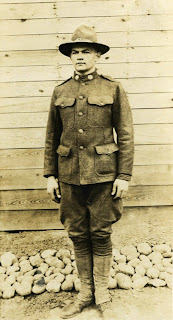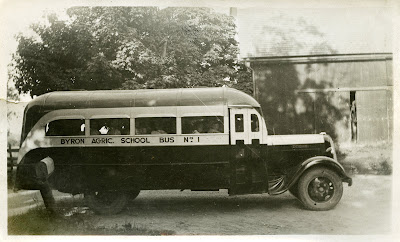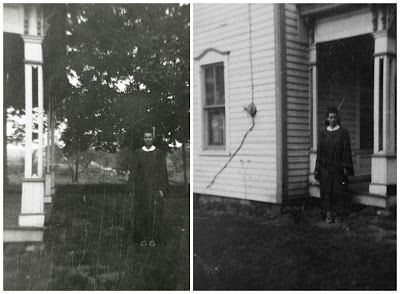 |
| Ralph and Florence Green, 1943 |
My great-grandfather has always been a bit of a mystery to me. I never heard Grama volunteer information on the subject, and I never thought to ask until it was far too late. I knew he was from the Flint area. I also knew his parents died when he was young; someone mentioned they may have been doctors, and that one or both were killed in a car accident. I also knew he was wounded in France during World War I, an injury that left him with chronic pain for the rest of his life. Everything else has come together in bits and pieces.
Ralph Orville Green was born in Flushing, MI, in 1892, the youngest child of Charles Herbert Green and Mary Effie Taylor. His maternal grandfather was Lewis Taylor, a medical doctor in Flushing, which clarifies that tidbit of history. In 1899 Ralph's father died of typhoid fever, leaving seven-year-old Ralph and his two siblings (Everett and Edna) to be raised by their mother - the 1900 census lists her as the head of household. All of their grandparents were deceased by that time, so he did not have much family around.
 |
| Ralph Green, 1917-18 |
Just a few years later, in 1906, Ralph's mother died at the age of 42; by then, his brother Everett was living in Ohio with his wife, Nellie, and young daughter Elloise. When the 1910 census came around, Everett was back in the Flint area with his family, and his sister, Edna (age 22), was living with them. Ralph, however, was living with Jules and Hattie Houle in 1910 (and 1920). The Houles are referred to several times in later letters from Florence to her mother, and they considered him family.
On June 5, 1917, when he was 25 years old, Ralph registered for the draft, claiming exemption due to his occupation as a farmer. Whether he volunteered soon afterward or was called up for service, I don't know, but either way, he soon found himself an enlisted man of the 115th Infantry Regiment, Company G, training at Camp McClellan and bound for France.
One resource I came across, entitled
The 115th Infantry, USA, in the World War, is available online and contains details and photos of the regiment during the war (Ralph is listed on page 229). Recorded by the chaplain, it covers everything from training to crossing the Atlantic and, finally, travelling via train, truck, and foot across France. There they wound up on the front lines, in the trenches near Verdun. The regiment played a major role in the
Meuse-Argonne Offensive, a six-week-long battle that led up to the end of the war. There were estimated 117,000 US casualties during the campaign (over 26,000 killed), and right in the midst of it was Ralph vs. a machine gun.
Ralph was shot in the leg around October 10, about a month before the armistice on November 11. The bullet came from "a
Fritz machine gun," meaning a German weapon, but I'll let him tell the story, from a letter he wrote to the Houles.
Friday Oct. 18, 1918
Somewhere in France
My Dear ones at home,
I will write you a few lines to let you know I am still alive and doing fine but gee it is hard work to lay so still in bed so long and this is only eight days and to think it might be nearly that many weeks before I can get up and walk much, but thank God it is no worse than it is there are many much worse off than me and many that are past there [sic] suffering that will never return, for this is an awful war, but thank God we all think it is near over. Hope and pray so anyway.
 |
| From The 115th Infantry, U.S.A., in the World War by F.C. Reynolds. |
Well I suppose you are anxious to here [sic] how and where I am wounded. I got hit in the left leg with a shot from a fritz machine gun. It hit the bone and shattered it so that there were several pieces to be removed and it will take some time for it to lengthen out and grow together again you see.
 |
| From The 115th Infantry, U.S.A., in the World War by F.C. Reynolds. |
Sunday afternoon will try and finish this letter. Don't know of much I can write, I am feeling pretty fair and getting along very good. The weather is very cold and cloudy and the days seem long and dreary and that's the way it goes here in France.
I don't know when I will here [sic] from you again as it will take some time to get my mail forwarded as it will go to the Co. and they don't know where to send it so it will go to the main headquarters and might fin'ly get to me but it will be good when it does come. I see by the papers that the huns are still on the run.
Hope this will find you all well. Will close for this time hoping to here [sic] from you soon. Good bye with love and best wishes.
From your boy,
Ralph O. Green
Co.G 115th US Inf.
After the war Ralph met my great-grandmother, Florence Brown, and they were married in 1922. They lived in Flint for a few years, where my grandmother was born. During their time there, Mrs. Houle was hit by a car and died shortly thereafter, an event described in detail by one of Florence's letters home. More about that in another post... but it seems I found the source of the rumor of his parent(s) being killed in a car accident.
 |
| Florence, Margaret, Harold, Ralph Green, 1928-29 |
Soon their son Harold came along, and it wasn't too long before the Greens moved to Byron, settling on a farm close to Florence's parents' home. The next years must have been difficult as the Great Depression descended on the country, but life moved onward and the kids
grew up, married, and added their own children to the family. That pretty much brings this to a close! I never had the opportunity to meet my great-grandparents, as Florence died rather unexpectedly in 1954, and Ralph in 1966, but I imagine they were honest, hard-working, and more than a little tough from the challenges they faced.




























